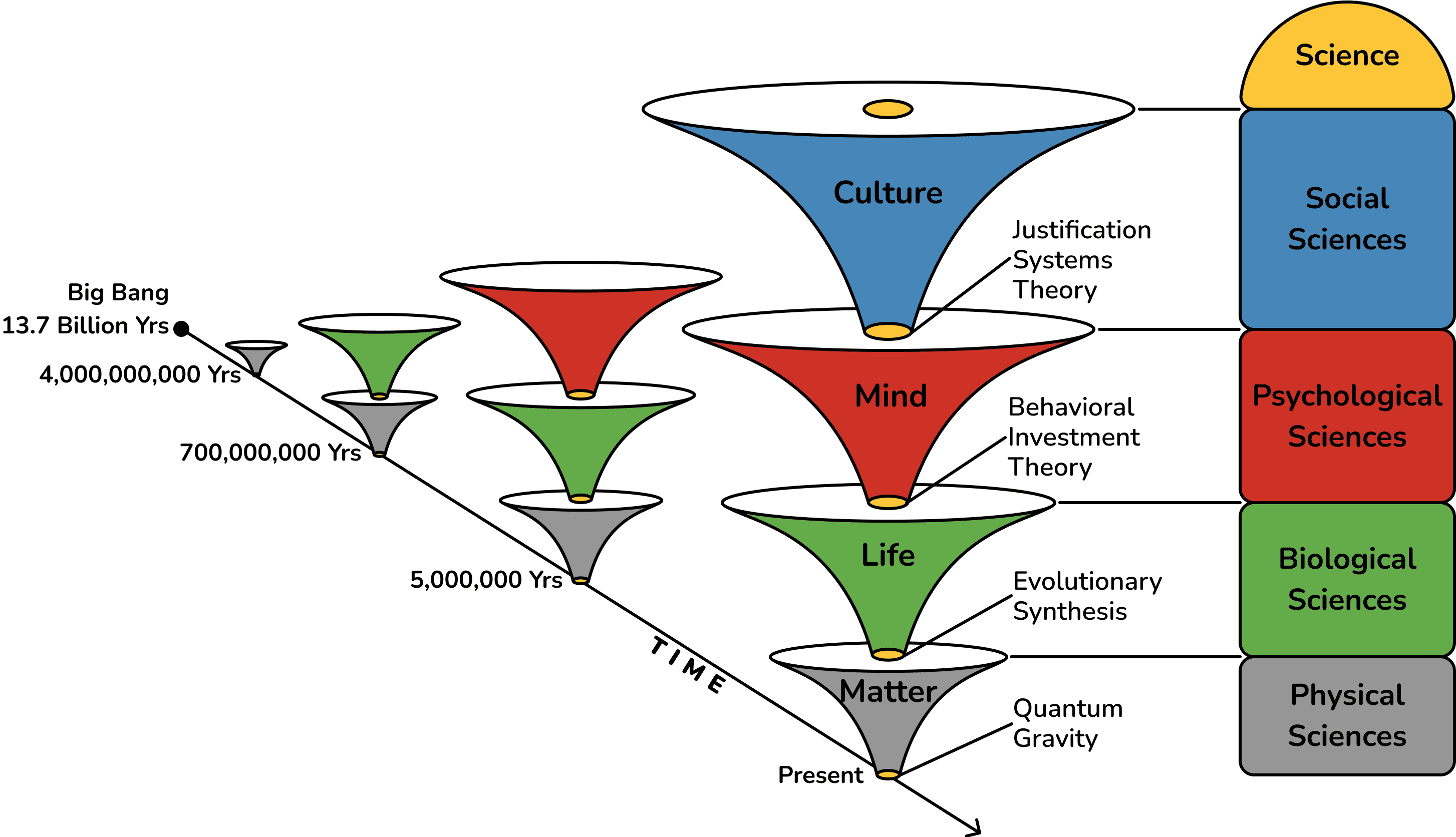The Tree of Knowledge (ToK) System is the first of UTOK’s key concepts and forms a cornerstone of its descriptive metaphysical framework. It works in conjunction with the Periodic Table of Behavior and Map of Mind to provide a coherent map of reality from matter to culture.
Core Framework of the ToK System
The ToK System provides a comprehensive descriptive metaphysical framework that aligns the planes of existence—Energy, Matter, Life, Mind, and Culture—with the major domains of science, including physical, biological, psychological, and social sciences. This visual logic of the ToK System offers a dual function: it defines broad concepts (such as life and mind) and elucidates their interrelationships within a coherent knowledge system.
Alignment of Planes of Existence with Scientific Domains
Energy: The foundational plane of existence, which is the basis for all subsequent planes. It encompasses the fundamental forces and particles that form the universe. This plane is primarily explored by the fields of physics and cosmology.
Scientific Domain: Physics
Key Concepts: Fundamental forces, subatomic particles, Big Bang
Matter: Emerging from the plane of Energy, the Matter plane involves the physical substances that make up the universe, from atoms to complex structures like planets and stars.
Scientific Domain: Physical Sciences (Physics, Chemistry)
Key Concepts: Atoms, molecules, states of matter, chemical reactions
Life: The biological plane, emerging from Matter, is characterized by the presence of life forms, from the simplest single-celled organisms to complex multicellular entities. This plane is explored by the biological sciences.
Scientific Domain: Biological Sciences (Biology, Ecology)
Key Concepts: Cells, genetics, evolution, ecosystems
Mind: Emerging from the plane of Life, the Mind plane involves the cognitive and mental processes found in animals, particularly those with nervous systems. This plane is the focus of psychological sciences.
Scientific Domain: Psychological Sciences (Psychology, Cognitive Science)
Key Concepts: Consciousness, perception, emotion, thought processes
Culture: The social plane, emerging from Mind, involves the complex social structures and cultural norms developed by humans. This plane is studied by the social sciences.
Scientific Domain: Social Sciences (Sociology, Anthropology)
Key Concepts: Social norms, cultural practices, institutions, collective behavior
Visual Logic and Dual Function
The visual logic of the ToK System serves two critical functions:
Definition of Broad Concepts: The ToK System provides clear definitions for broad concepts like life and mind. By situating these concepts within specific planes of existence, the system clarifies what is meant by each term and how it can be studied within its respective scientific domain. For example, "life" is situated within the biological plane and involves processes such as metabolism, reproduction, and evolution, making it clear that the study of life belongs to the biological sciences.
Elucidation of Interrelationships: The ToK System elucidates the interrelationships between these broad concepts within a coherent knowledge framework. It shows how each plane of existence builds upon and emerges from the previous one, creating a nested hierarchy. This hierarchical structure allows for a comprehensive understanding of how different domains of science are interconnected. For instance, understanding biological life (Life plane) requires knowledge of chemical processes (Matter plane), and understanding mental processes (Mind plane) requires an understanding of biological organisms (Life plane).
Hierarchical and Emergent Properties
The ToK System also emphasizes the hierarchical nature of existence, where each plane represents a higher level of complexity and organization emerging from the one below it. This emergence is characterized by novel properties and information processing systems unique to each plane:
Energy to Matter: The transition from pure energy forms to stable matter involves the emergence of fundamental particles and forces.
Matter to Life: The emergence of life involves complex biochemical processes and self-replicating molecules, leading to cellular life.
Life to Mind: The development of nervous systems and brains allows for complex behaviors, perception, and cognition.
Mind to Culture: The evolution of language, social structures, and cultural practices enables advanced social organization and collective behaviors.
By mapping these emergent properties, the ToK System provides a robust framework for understanding how complexity arises at each level of existence and how it can be studied scientifically.
Theory and Planes of Existence
A distinctive feature of the ToK System is its representation of reality through four planes of existence:
Matter: The physical plane, studied by physical sciences.
Life: The biological plane, studied by biological sciences.
Mind: The psychological plane, studied by psychological sciences.
Culture: The social plane, studied by social sciences.
Each plane of existence represents a complex adaptive landscape mediated by novel emergent information processing and communication systems. Following the plane of Matter, the planes of Life, Mind, and Culture are viewed as hierarchically nested dimensions of existence, each characterized by unique emergent properties.
Detailed Explanation of Each Plane
Matter
Definition: The physical plane, encompassing all physical entities and phenomena.
Studied by: Physical sciences (Physics, Chemistry).
Characteristics: Governed by fundamental physical laws and forces. This includes the study of atoms, molecules, states of matter, and physical interactions such as gravity, electromagnetism, and nuclear forces.
Life
Definition: The biological plane, encompassing all living organisms.
Studied by: Biological sciences (Biology, Ecology).
Characteristics: Defined by processes such as metabolism, reproduction, genetic inheritance, evolution, and ecological interactions. Life forms exhibit properties such as growth, adaptation, and response to stimuli, distinguishing them from inanimate matter.
Mind
Definition: The psychological plane, involving conscious and unconscious mental processes.
Studied by: Psychological sciences (Psychology, Cognitive Science).
Characteristics: Includes cognition, perception, emotion, and behavior. This plane explores how nervous systems process information, how animals and humans perceive their environments, make decisions, and engage in complex behaviors.
Culture
Definition: The social plane, involving human societies and cultural practices.
Studied by: Social sciences (Sociology, Anthropology).
Characteristics: Encompasses social structures, norms, values, traditions, languages, and collective behaviors. This plane examines how humans create, maintain, and transform cultural and social systems, and how these systems influence individual and group behavior.
Emergent Information Processing and Communication Systems
Each plane is mediated by distinct information processing systems that contribute to the complexity and functionality of that plane:
Matter: Physical interactions and forces, such as chemical bonds and physical laws.
Life: Biological information systems, including DNA, cellular communication, and homeostasis mechanisms.
Mind: Neural networks, cognitive processes, and sensory-motor integration.
Culture: Language, symbols, social norms, and cultural institutions.
These systems illustrate how complexity and novelty emerge at each hierarchical level, enabling new forms of organization and interaction.
Epistemology and Methodology
Science as a Justification System
Natural science is portrayed within the ToK System as a specific type of justification system that emerges within the Culture plane. This system is characterized by:
Exterior Viewpoint: Observing phenomena from an objective, detached perspective. This approach seeks to minimize subjective bias and relies on measurable, observable data.
Quantification: Using measurement and mathematics to describe phenomena. Quantitative methods allow for precise, repeatable experiments and the development of predictive models.
Experimentation: Testing hypotheses through controlled, repeatable experiments. This method enables scientists to establish causal relationships and validate theories.
These epistemological commitments help justify scientific ontology, mapping the ontic reality of the planes of existence. This structured approach ensures that scientific knowledge is based on empirical evidence and logical reasoning.
Mapping Ontic Reality
The ToK System maps the domains of physical, biological, psychological, and social sciences onto the ontic dimensions of matter, life, mind, and culture. This structured mapping clarifies how different scientific disciplines relate to each other and to the various planes of existence, providing a comprehensive framework for interdisciplinary understanding.
For example:
Physics and Chemistry: Map onto the Matter plane, studying the fundamental constituents and interactions of physical reality.
Biology and Ecology: Map onto the Life plane, exploring the complexity of living systems and their interactions with the environment.
Psychology and Cognitive Science: Map onto the Mind plane, investigating mental processes and behaviors.
Sociology and Anthropology: Map onto the Culture plane, examining the structures and dynamics of human societies and cultures.
This mapping provides a holistic view of scientific inquiry, showing how each discipline contributes to a broader understanding of reality.
Addressing Key Problems
The Enlightenment Gap
The Enlightenment Gap refers to the historical separation between the understanding of physical (matter) and mental (mind) phenomena. The ToK System bridges this gap by providing a coherent map that places mind in relation to matter, illustrating how mental phenomena emerge from physical processes. This integration clarifies the nature of science as a unique justification system within the Culture-Person plane of existence.
The Problem of Psychology
The fragmented state of psychological science is addressed by the ToK System through a clear distinction between the Mind-Animal dimension (psychological processes) and the Life-Organism (biological processes) and Culture-Person (social processes) dimensions. This delineation provides the foundational structure needed to unify psychological science, defining its subject matter—mental behavior—within a broader metaphysical context.
Metaphysical Empirical System
Framework for Interdisciplinary Collaboration
The ToK System promotes a shared "metaphysical empirical" framework that scientists across all disciplines can operate within. By mapping the hierarchical dimensions of existence and defining their interrelations, the ToK System fosters interdisciplinary collaboration and a unified approach to understanding reality. This framework addresses the fragmented pluralism that has characterized much of modern scientific inquiry, offering a robust solution for a coherent and integrated scientific enterprise.
Conclusion
The ToK System is a transformative approach that redefines how we understand and organize knowledge across various scientific disciplines. By providing a clear, hierarchical mapping of the dimensions of existence, the ToK System not only addresses historical philosophical gaps but also paves the way for a more integrated and coherent scientific inquiry. For a more detailed and comprehensive understanding of the Tree of Knowledge (ToK) System, readers are encouraged to refer to Gregg Henriques' works, including "A New Unified Theory of Psychology" and "A New Synthesis for Solving the Problem of Psychology: Addressing the Enlightenment Gap."
Visual Aids
Links & Resources
For those interested in delving deeper into the Tree of Knowledge System and the Unified Theory of Knowledge, here are some recommended resources:
📖 Books by Gregg Henriques:
A New Unified Theory of Psychology
A New Synthesis for Solving the Problem of Psychology: Addressing the Enlightenment Gap
📜 Articles and Papers:
🎞️ Educational Videos and Series:
Now UTOKing: The Meta-Crisis & the 5th Joint Point - YouTube Series.
The UTOK 20 - A detailed series explaining the core elements of UTOK.
🌐 Online Resources:






